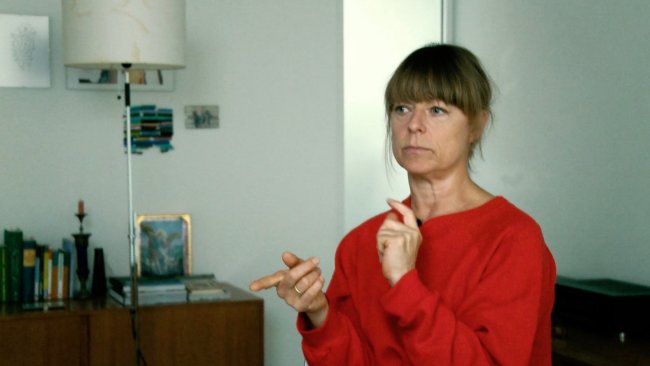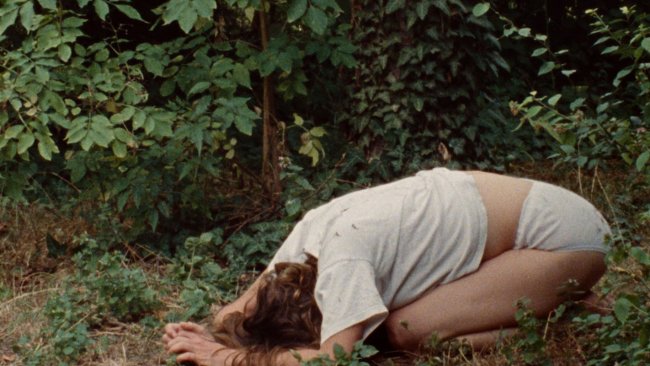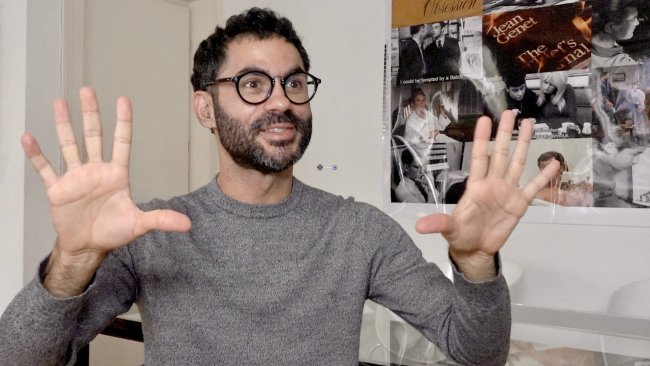Samsara | Lois Patiño
The team of FILMEXPLORER’s Live Radio at the Bildrausch Filmfest 2023 met Lois Patiño on the Stadtkino Piazza in Basel to discuss his last wonderful filmic work «Samsara».
Here below two different critical perspectives on the film, by Giuseppe Di Salvatore and Călin Boto.
Text: Călin Boto, Giuseppe Di Salvatore | Audio/Video: Giuseppe Di Salvatore, Emilien Gür
Podcast
Samsara | Lois Patiño
Interview by Giuseppe Di Salvatore and Emilien Gür | Editing: Olivier Legras
Find a list of all our Podcasts here.
The peace of discipline of a group of children-monks in Laos opens the film, then soon leaves room to the curiosity of one young boy: Amid. On the basis of religious diversity – animism and Buddhism in contemporary Laos – this shift from discipline to curiosity does not lead to secularisation but to a spiritual journey, which can be said interreligious and critical. The Tibetan book of the Bardo, that is effectively read (and not repeated) by Amid to an old dying woman, is the key to enter the world of afterlife. This is actually the world of inter-lives, between two lives, right before reincarnation. The young boy embodies the mediation and the access to this inter-life world and the complex theme of reincarnation. In this respect, I cannot but recall another cinematic young hero of mediation – Joseph Losey’s wonderful figure of the boy in Go-Between (1971). While in Losey’s (originally Harold Pinter’s) story we get in touch with the troubles of love, in the first part of Samsara we get in touch with death as a harmonic process of passage, or initiation to a new journey beyond actual life. The oneiric atmosphere of this first part, beautifully shot by Mauro Herce’s sensual camera, anticipates the Bardo status in an allusive way, through the recurrence of scenes of sleep, dream, daydream... In this, one must recognise the specific feature of the cinema experience, equally an intermediate status between the mind’s and the world’s lives. Cinema is also a sort of Bardo.
Now Lois Patiño takes this connection between the inter-lives and cinema literally, and proposes a surprising upgrading of our cinematic experience: from our experience (immersed) within the screen to an experience of the screen as source of light without projected images. After having closed our eyes – as the film asks of an audience, which in this way become interactive – we will project our own images while following a suggestively designed sound track (Xabier Erkizia). This kind of expanded cinema experience (expanded through reduction…) carries us to another life and another reality. The different location – Zanzibar – and the different protagonists – a young girl and a goat – are underlined by another style of cinematography: Jessica Sarah Rindland’s one, more haptic and less pictorial than in Laos. As an element of continuity between the different parts of the film and the different lives, the sound embodies the continuity between the human and the more-than-human perspective. Other elements enhance this continuity through a play of echoes between the Laos and the Zanzibar’s parts: details but also a major intercultural/interreligious thread, explicitly described in Zanzibar through the cohabitation of the Masaai and the Muslims.
One could suspect Patiño’s filmic journey of utopic pacifism, but the singular perspective that is spiritual and literally more-than-human effectively allows us to see a connection between all living (and probably also non-living) beings far beyond the current conflicts and injustice, certainly not absent in places akin to Laos or Zanzibar. From this global and existential perspective, it becomes plausible to train us to see a concrete possibility of harmony and peaceful cohabitation of cultures and religious. Note, Samsara is not an a-political film but still contains a political tonality, to the extent that politics is definitely not only a question of claims and fight against evil behaviour, but also a question of positive examples on which we can rely upon. To this end, Patiño’s film is full of moments of trust, whose beauty motivates and inspires.
Giuseppe Di Salvatore
*
Lois Patiño seems sure of his salvation and wants to reassure others. Samsara, a darling of recent film festivals, might impress: its serene cinematography, soft mise-en-scène, and mystical omniscience light up the screen with their auratic images; but it’s no more than the artificial light of a white neon elephant.
Especially in the first part of the triptych (a slow-burn tale of boyhood and passing), action is losing itself in another time, that of nonfictional-like observations of daily rituals in a Buddhist temple from Laos, with its religious choreographies, communal way of life, vegetal and animal pulsations. Villager Amid (Amid Keomany), a boy from outside, catches the eye of young monk Bee Ann (Toumor Xiong). A Buddhist himself, but Tibetan (there is no religious tension in Patiño’s world, only respectful understanding), Amid crosses the surrounding lake every day to read from a traditional scripture to an old lady, Mon (Simone Milavanh), who’s expecting death - meaning rebirth - anytime soon, and what the boy is reading to her is believed to be a spiritual guide through Bardo, the liminal state between lives. Bee Ann asks if he and some novices could be taken by boat to the other side of the lake the following day, which Amid agrees on, without making it clear if any payment is necessary. The time to spoil the mesmerizing tableaux with reality-checks just passed, in a previous talk between Bee Ann and another monk about monasticism as an individual escape from poverty. As in a future sequence, when some Tanzanian women speak among themselves about their gendered and exploitative work as seaweed pickers, the dialogue between the two boys feels unnecessarily precautious, as if forcefully legitimating itself as more than a spiritual reverie, yet without being much more (and why wouldn’t it be enough?). These isolated moments of political awakening, just as those insisting on smartphones as brief landscape updates, do nothing more than emphasize Patiño’s structural rigidity and overall callophilia. What at first glance seems an artful celebration of the haphazard, its small gestures and uncontrolled time soon lays bare, as a stressed-out attempt to turn many standard epiphanies of nowadays’ experimental cinema (formal as well as thematic: celluloid artifacts, slow time, otherness, intense natural soundscape, etc.) into a frozen, specious masterpiece, during which everything happens at the right time and in the right place. As such, some prophetic lines of Mon about reincarnating into an animal, or later of an old Tanzanian Islamic woman explaining to her granddaughter how some peoples even believe in transspecies reincarnation, might come out as less profound if simply considered bad scriptwriting, symptomatic to the director’s holistic narrative.
As already suggested, Mon indeed reincarnates: into a baby goat born in Zanzibar. But between one and another, Patiño asks his spectators to close their eyes for a sound interpretation of Bardo (“The pure truth will be revealed to you in a rapid vision”, as Amid finally reads to her corpse.) It’s a beautiful experience of collective meditation, the one and only risk assumed by the film; to the non-believer, it’s at least the chance for a humanistic moment (15 minutes) of togetherness, cross-referenced to watching films as a ritual, to our image-centric times, with the screen flickering and the speakers bringing together a history of the world in sounds. However, it’s not enough, as Samsara would go on as an Avatar of marginal cinema in its third part just as well. Actually, one of the most exciting and sensible aspects of it hasn't been widely remarked upon but has to do with the on-screen presence of that lamb. Not because anthropomorphism is unfamiliar to cinema, but Mon has been seen only a few times in her human form before reincarnating, so, oddly enough, the spectator assumes much about her previous self by watching this goatling simply being, forcing sense out of two unknowns. Such a little fable-like trick works surprisingly well for Patiño’s aims, much better, unfortunately, than most of his other efforts to transcend.
Călin Boto
This article contains a third-party video. If you would like to watch the video, please adjust your settings.
Watch
Screenings at the Festival Black Movie Genève 2024
Info
Samsara | Film | Lois Patiño | ES 2023 | 107’ | Bildrausch Filmfest Basel 2023, Black Movie Genève 2024
First published: June 04, 2023




